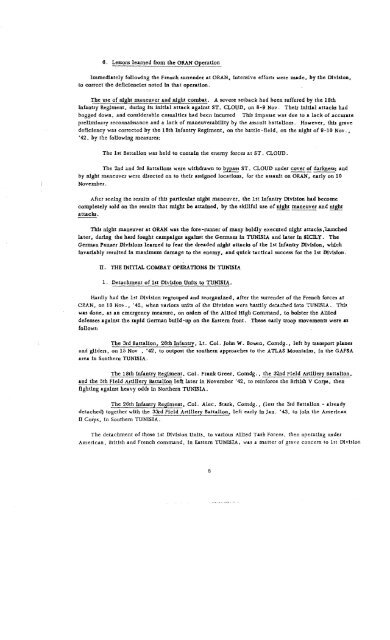KASSERINE PASS BATTLES Readings - US Army Center Of Military ...
KASSERINE PASS BATTLES Readings - US Army Center Of Military ...
KASSERINE PASS BATTLES Readings - US Army Center Of Military ...
Create successful ePaper yourself
Turn your PDF publications into a flip-book with our unique Google optimized e-Paper software.
6 . Lessons learned from the ORAN Operation<br />
Immediately following the French surrender at ORAN, intensive efforts were made, by the Division,<br />
to correct the deficiencies noted in that operation . _<br />
The use of night maneuver and night combat . A severe setback had been suffered by the 18th<br />
Infantry Regiment, during its initial attack against ST . CLOUD, on 8-9 Nov . Their initial attacks had<br />
bogged down, and considerable casualties had been incurred This impasse was due to a lack of accurate<br />
preliminary reconnaissance and a lack of maneuverability by the assault battalions . However, this grave<br />
deficiency was corrected by the 18th Infantry Regiment, on the battle-field, on the night of 9-10 Nov . ,<br />
'42, by the following measures ;<br />
The 1st Battalion was held to contain the enemy forces at ST . CLOUD .<br />
The 2nd and 3rd Battalions were withdrawn to bypass ST . CLOUD under _cover of darkness; and<br />
by night maneuver were directed on to their assigned locations, for the assault on ORAN, early on 10<br />
November .<br />
After seeing the results of :his particular night maneuver, the 1st Infantry Division had become<br />
completely sold on the results that might be attained, by the skillful use of night maneuver and night<br />
attacks .<br />
This night maneuver at ORAN was the fore-runner of many boldly executed night attacks launched<br />
later, during the hard fought campaigns against the Germans in TUNISIA and later in SICILY . The<br />
German Panzer Divisions learned to fear the dreaded night attacks of the 1st Infantry Division, which<br />
invariably resulted in maximum damage to the enemy, and quick tactical success for the 1st Division .<br />
II . THE INITIAL. COMBAT OPERATIONS IN TUNISIA<br />
1 . Detachment of 1st Division Units to TUNISIA .<br />
Hardly had the 1st Division regrouped and reorganized, after the surrender of the French forces at<br />
CP,AN, on 10 Nov . . '42, when varlor_s units of the Division were }rastll} detached into UNLMA . This<br />
was done, as an emergency measure, on orders of the Allied High Command, to bolster the Allied<br />
defenses against the rapid German build-up on the Eastern front . These early troop movements were as<br />
follows :<br />
The 3rd Battalion, 26th Infantry , Lt . Col . John W . Bow-a . Comdg., left by transport planes<br />
and gliders, on 15 Nov , '42, to outpost the southern approaches to the ATLAS Mountains, in the GAFSA<br />
area In Southern TUNISIA .<br />
The 18th Infantry Regimen t , Col . Frank Greet, Comdg ., the 32nd Field Artillery Battalion ,<br />
and the 5th Field Artillery Battalion left later in November '42, to reinforce the British V Corps, then<br />
fighting against heavy odds In Northern TUNISIA .<br />
The 26th Infantry Regiment , Col . Alec . Stark, Comdg ., (less the 3rd Battalion - already<br />
detached) together with the 33rd Field Artillery Battalion, left early in Jan. '43, to join the American<br />
11 Corps, in Southern TUNISIA .<br />
The detachment of these 1st Division Units, to various Allied Task Forces, then operating under<br />
American, British and French command, !n Eastern TUNISIA, was a matter of grave concern to 1st Division

















